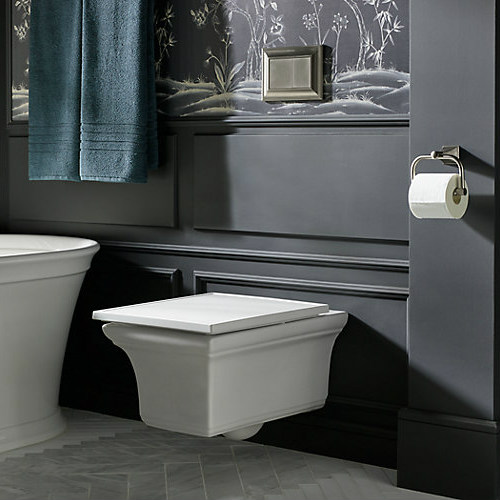A wall-mounted toilet is the kind of thing that you might see in an interior design magazine or on a Pinterest board. Sleek and sophisticated, these toilets save space and can help to open up a room, which is perfect for smaller bathrooms. Besides that, they’re just nice to look at and add a more contemporary feel to the bathroom. If you’re considering a wall-mounted toilet check out the pros and cons of these toilets below.
A Minimalist’s Dream
The reason a wall-mounted toilet looks so minimal is that its water tank sits within the wall, so it’s out of plain sight. This creates a much more streamlined look and can also grant more space for other design components. For those looking for a simple, clean look, a wall-mounted toilet is quite appealing. Minimalists will rejoice at the elegant lines and simple shapes while also being able to hide trapways and internal parts behind a wall.
How does a Wall Mounted Toilet Work?
While a wall-mounted toilet looks straightforward, there might be some confusion as to how it works, especially for people who aren’t familiar with them. These toilets may have a round or elongated bowl and it’s not uncommon for them to come with a dual-flush system, meaning that you can control how much water is used in each flush. The flusher button might sit on the unit itself (typically behind the bowl), or it might be on the wall via a sort of control panel. Either way, it’s quite obvious and doesn’t ruin the streamlined look.
As for the tank, it is usually made of plastic and styrofoam, lightweight materials that can sit out of sight behind the wall. Don’t worry, the tank gets boxed into a carrier unit that is usually made of steel or cast-iron, keeping it protected. The seat is anchored to that carrier via studs in the drywall, holding it securely in place.
Pricing?
If these toilets look expensive, it’s because they are. Expect to shell out close to a thousand dollars (or more) for these fancy fixtures.
Wall-Mounted Toilet Advantages
A cool thing about these toilets is that you can have them installed to the specific height that best suits you. For reference, most wall-mounted toilets sit 15 to 19 inches above the floor. Another advantage is that they’re easy to clean since they’re not bolted to the floor like conventional toilets. There’s little need to contort your body around to the back of the toilet to give it a good scrubbing.
Also, wall-mounted toilets (read reviews) grant you more flexibility when designing your dream bathroom. You have more space to play around, and you’ll automatically have a contemporary-looking space that suits your style tastes. Speaking of designing, these toilets do a good job of abiding by building codes since many municipalities require that toilets have at least 21 inches of clear space in front of them.
Some Disadvantages to Wall Mounted Toilets
Of course, a wall-mounted toilet does come with its downsides. For one thing, they are expensive, which is the primary reason that many homeowners bypass them as an option. Installing a wall-mounted toilet will require a big wallet and large-scale bathroom remodeling, as this is not a DIY project.
While homeowners may be able to install their own conventional toilet, a wall-mounted fixture is a different story. You will need a professional to ensure that everything is safe and up to code. That’s an added expense on top of the hefty price tag of a wall-mounted model. Since they require a bit of a bathroom overhaul, things can get a bit invasive and pricey. Even so, for some homeowners, the look and feel of a wall-mounted toilet make it worth it.
There is a small access point to the water tank where the flusher button is, which works for simple things like unclogging and adjusting the flapper. Otherwise, repairs and installation will require opening the wall, rerouting the wastewater pipes, and patching up the floor where your conventional toilet once sat.
In addition, older homes may require a new set of studs to keep the wall-mounted toilet in place. All of that can add up to more money poured into the project. Some homeowners get around this issue by opting for a customized access panel in the drywall that opens to the behind-the-wall components.

